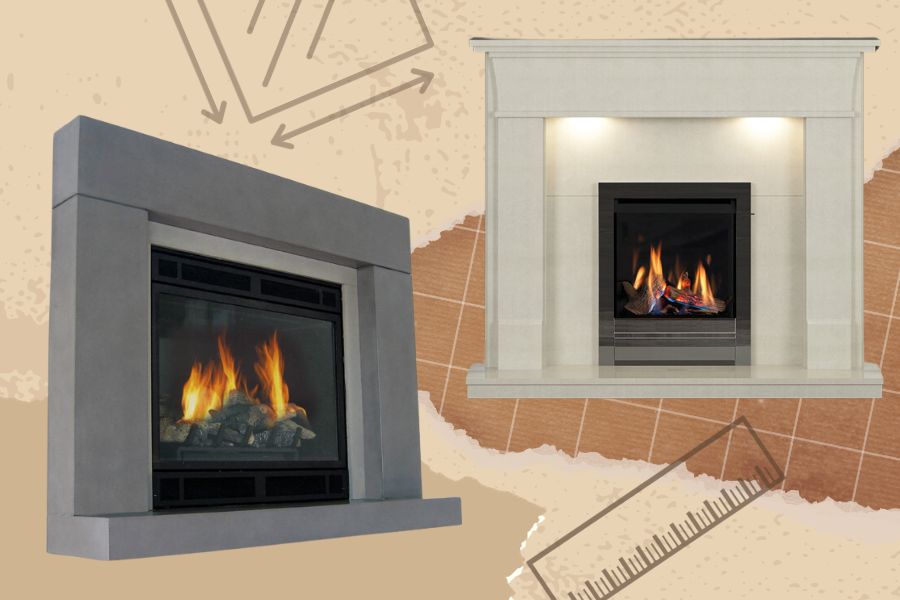Gas fireplaces have become popular for homeowners due to their convenience, efficiency, and aesthetic appeal. However, ensuring the safety of these heating appliances is of paramount importance. Understanding and complying with gas fireplace surround code requirements is essential not only for ensuring the safety of your home but also for meeting legal standards.
In this article, we will delve into the crucial gas fireplace surround code requirements that you need to be aware of. From understanding the significance of a hearth to exploring regulations outlined by local building codes, we will cover a range of topics to help you create a safe and compliant gas fireplace setup.
Gas Fireplace Hearth Requirements With Examples
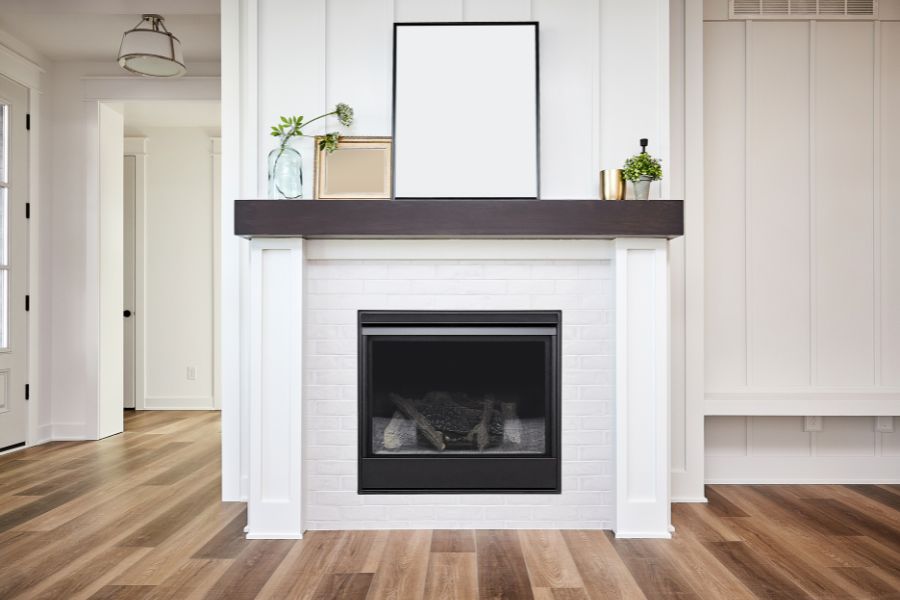
A gas fireplace hearth serves as a vital safety component, preventing heat from transferring to combustible materials and creating a safe zone around the front vent gas fireplace. To understand the significance of adhering to hearth requirements, let’s explore real-life examples that highlight the importance of proper hearth design.
Consider the scenario of a family room where a gas fireplace was installed without a proper hearth. The absence of a hearth allowed heat to radiate directly onto a nearby wooden shelf, causing it to scorch and creating a potential fire hazard. This unfortunate incident could have been prevented with a well-designed hearth that acted as a barrier between the fireplace and the flammable shelf.
In another case, an elegant living room featured a beautiful gas fireplace with a stylish stone surround. However, the absence of a hearth meant that a rug was placed too close to the fireplace opening. Over time, the rug’s fibers started to melt due to the heat exposure.
A properly designed hearth would have ensured a safe distance between the fireplace chimney and a particular area of the rug, avoiding damage and potential safety risks.
These real examples emphasize the importance of adhering to gas fireplace hearth requirements. Whether aiming for aesthetics or preventing accidents, a well-designed hearth is your defense.
By maintaining the required clearance and materials outlined in the guidelines, you can create a gas fireplace hearths setup that not only exudes beauty but also prioritizes safety, preventing potential fire hazards and ensuring the well-being of your home and loved ones.
Factory Built Fireplaces
When it comes to factory-built fireplaces, their allure lies in both their modern design and convenience. These pre-engineered units come with specific installation guidelines that ensure efficient combustion, proper ventilation, and most importantly, safety.
Built with these guidelines in mind, factory-built fireplaces offer predictability in terms of performance and compliance.
As we delve into the realm of factory-built fireplaces, we’ll guide you through the essential steps, ensuring that your installation not only exudes elegance but also adheres to critical safety standards.
Do Gas Fireplaces Need A Hearth?
The hearth isn’t just a decorative touch; it’s a safety requirement for gas fireplaces. Its purpose extends beyond aesthetics for safety reasons, acting as a protective barrier that prevents excessive heat from reaching combustible materials.
In answer to the question, yes, gas fireplaces do need a hearth like traditional fireplaces. Whether you’re pondering the necessity of a hearth wood-burning fireplace or seeking alternative solutions, we’ll provide you with comprehensive explanations.
By understanding the role of the hearth and its compliance with code requirements, you can ensure that your gas fireplace setup offers both beauty and security.
Seattle Building Code Regulations for Fireplace Hearths
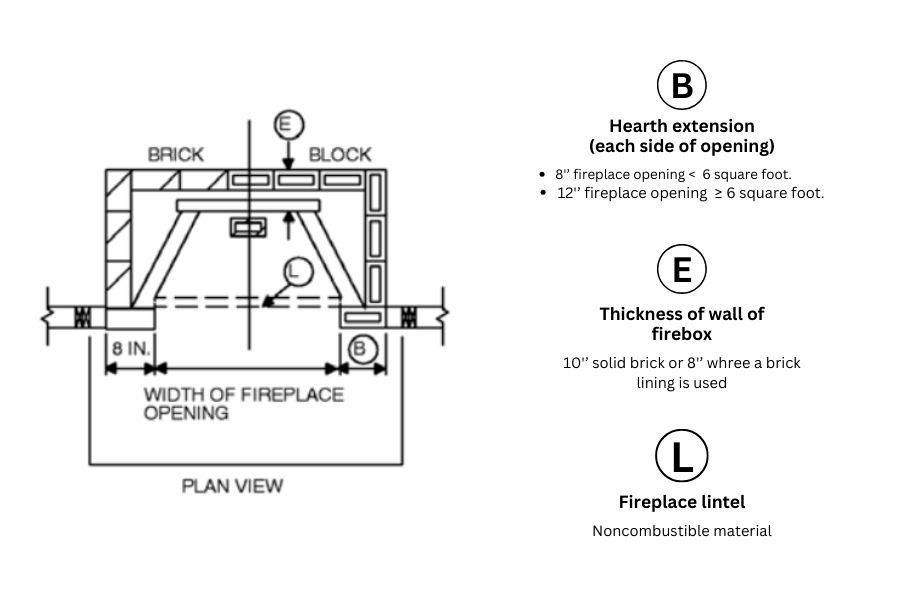
Safety is of utmost importance in the bustling city of Seattle, and this focus is evident in the precise building code regulations concerning fireplace hearths.
According to the Seattle Building Code, they closely regulate the dimensions, materials, and positioning of hearths to safeguard both occupants and property.
For example, the code might stipulate a minimum distance that the hearth must extend from the fireplace opening and the allowable materials for its construction.
Formulating these regulations aims to prevent potential fire hazards and promote a secure and comfortable living environment. These regulations are formulated to avert potential fire hazards and foster a secure and comfortable living environment.
Adhering to Seattle’s building code regulations for fireplace hearths and modern fireplaces ensures compliance and contributes to your home’s overall safety and ambiance.
What Is A Hearth?
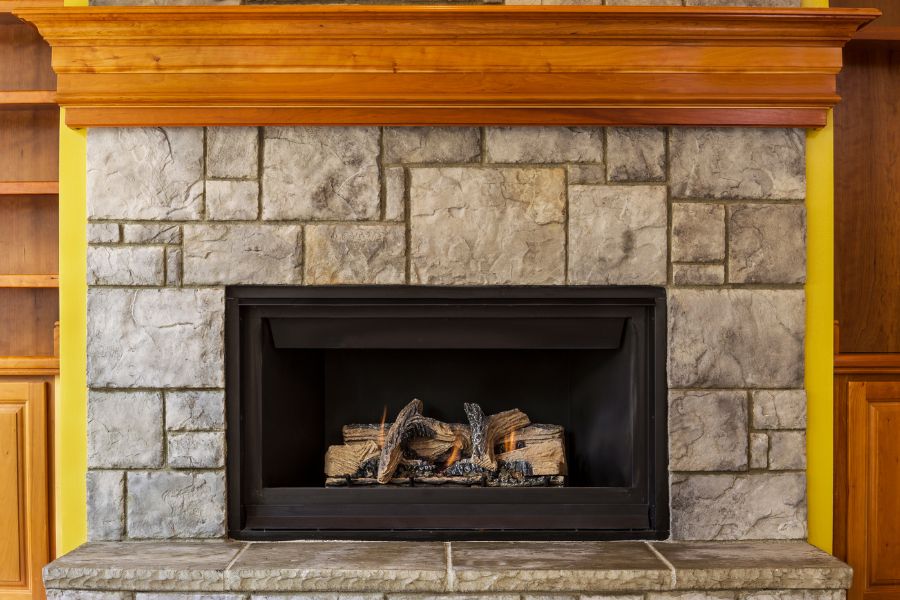
The hearth serves two vital roles at the core of any fireplace setup. Functionally, it acts as a safety barrier, shielding combustible materials from the heat of the fire. Aesthetically, it’s a canvas for your style, enhancing the overall look of your space.
Traditionally raised or contemporary and flush, the hearth’s purpose remains unchanged: to provide a secure area that lets you enjoy the fireplace’s warmth without worry.
Hearth Extension Dimensions
Ensuring the proper dimensions of your hearth extension is a pivotal step in creating a safe and compliant fireplace setup. The hearth extension dimensions directly influence its effectiveness in preventing heat transfer to combustible materials and maintaining a secure buffer zone.
Adhering to the specific measurements outlined in local building codes and manufacturer guidelines is crucial when extending the hearth.
These dimensions typically include the required clearance between the fireplace opening, the edge of the hearth extension, and any surrounding walls or structures. Additionally, the elevation and height of the hearth extension play a role in its functionality.
By carefully following these dimensions, you guarantee the safety of your living environment and contribute to the overall aesthetic appeal of your direct vent gas fireplace area.
Natural Vent Gas Fireplace Hearth Requirements
Installing a hearth for a natural vent gas fireplace entails several vital requirements to ensure safety and compliance. These regulations are designed to prevent potential fire hazards and maintain efficient fireplace operation.
The fireplace manufacturer’s specifications and local building codes dictate the minimum clearance from the fireplace opening, sidewalls, chimneys, and other structures. This clearance facilitates proper combustion and exhaust while safeguarding against excessive heat exposure to combustible materials.
The hearth’s construction materials, such as stone, brick, or concrete, must be non-combustible and heat-resistant. Adhering to specific dimensions and elevation ensures the hearth’s effectiveness in providing a secure buffer zone.
Always consult local codes and follow the manufacturer’s instructions and the manufacturer’s installation instructions very diligently to create a safe and functional hearth that enhances both the safety and aesthetics of your natural vent gas fireplace setup.
Gas Fireplace Types
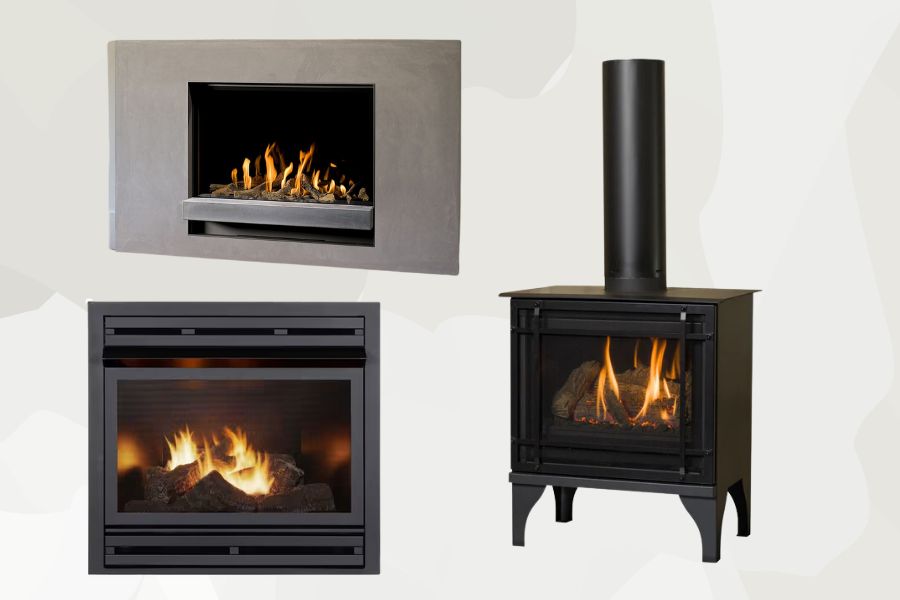
Gas fireplaces offer diverse options, each catering to different preferences and architectural styles. Three main types to consider are freestanding gas stoves, built-in gas fireplaces, and gas fireplace inserts.
Freestanding gas stoves bear resemblance to traditional wood-burning stoves and offer the flexibility to be placed nearly anywhere in your home.
You can install built-in gas fireplaces directly into walls or enclosures, resulting in a sleek and contemporary appearance.
You can retrofit gas fireplace inserts into existing wood-burning fireplaces, providing a convenient and efficient method to switch to gas. Each type comes with distinct installation prerequisites, ventilation factors, and design options.
By understanding the distinctions among these gas fireplace types, you can choose the one that best suits your style, needs, and safety requirements.
Direct Vent Gas Fireplaces Hearth Requirements
Direct vent gas fireplaces or natural vent gas fireplaces blend efficiency with elegance, often becoming the centerpiece of a room. These units require specific hearth setups to ensure proper combustion and safe operation.
Our guidance on direct vent gas fireplace hearth requirements will take you through these distinct mandates, offering insights into creating a stylish and secure hearth area that supports your direct vent gas fireplace that’s performance.
By adhering to these requirements, you can enjoy the benefits of a direct vent fireplace while upholding safety standards.
Other Gas-Powered Appliances
While our primary focus has been on fireplaces, it’s essential to acknowledge that gas-powered appliances extend beyond the hearth. Water heaters, stoves, and dryers also require careful installation and ventilation to ensure safety.
Exploring other gas-powered appliances will give you a thorough understanding of the safety measures that should be maintained throughout your home.
Recognizing the broader implications allows you to create a living space that prioritizes safety across various gas-powered appliances.
Floor Distance From Combustibles
The floor distance from combustibles is a vital safety consideration for your fireplace. This requirement establishes the minimum space that must be maintained between air inside the fireplace’s base and flammable materials like carpets or wood flooring.
The goal is to prevent the risk of ignition due to the fireplace’s heat. Gas fireplaces, for instance, typically need a few inches of clearance to ensure that nearby surfaces won’t catch fire or degrade from the heat.
It’s essential to check your fireplace’s specifications and local building codes to determine the exact distance required. By adhering to these guidelines, you’re creating a secure fireplace setup that allows you to enjoy the warmth without compromising safety.
Can You Paint A Fireplace Hearth?
Absolutely, you can paint a fireplace hearth, but there are important considerations to keep in mind. The hearth’s material, heat resistance, and safety regulations play a role in this decision.
When painting a fireplace hearth or mantel, opt for approved noncombustible material like heat-resistant paint specifically designed for high-temperature applications. This paint is formulated to withstand the fire’s intense heat without peeling or discoloring over time.
Conclusion
As we conclude our exploration of fireplace surround code requirements, it’s evident that safety and compliance are at the forefront of creating a warm and inviting space.
Gas fireplaces offer convenience, efficiency, and potential for aesthetic enhancement in your home.
From understanding the essential role of a hearth to delving into building code regulations and various fireplace types, you’ve gained insights into the intricate world of fireplace safety and design.

